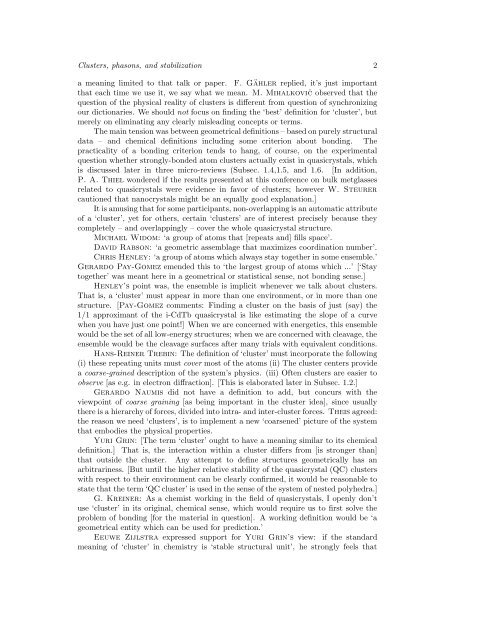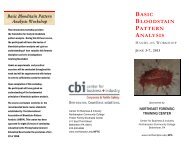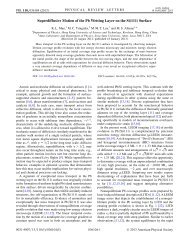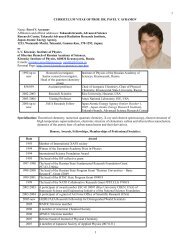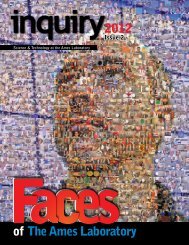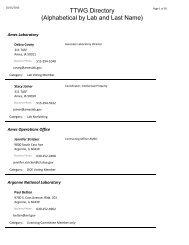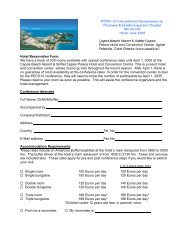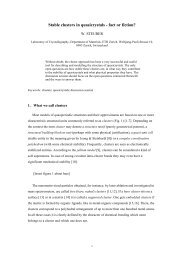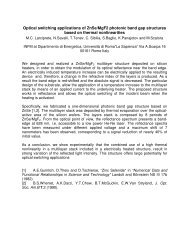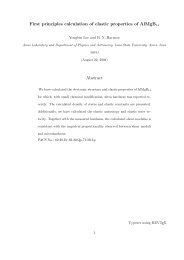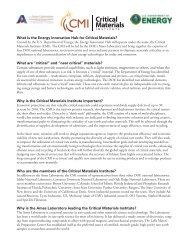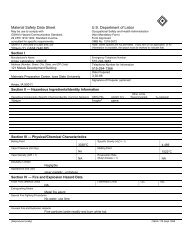Discussion on clusters, phasons, and quasicrystal stabilization
Discussion on clusters, phasons, and quasicrystal stabilization
Discussion on clusters, phasons, and quasicrystal stabilization
Create successful ePaper yourself
Turn your PDF publications into a flip-book with our unique Google optimized e-Paper software.
Clusters, phas<strong>on</strong>s, <strong>and</strong> stabilizati<strong>on</strong> 2a meaning limited to that talk or paper. F. Gähler replied, it’s just importantthat each time we use it, we say what we mean. M. Mihalkovič observed that thequesti<strong>on</strong> of the physical reality of <strong>clusters</strong> is different from questi<strong>on</strong> of synchr<strong>on</strong>izingour dicti<strong>on</strong>aries. We should not focus <strong>on</strong> finding the ‘best’ definiti<strong>on</strong> for ‘cluster’, butmerely <strong>on</strong> eliminating any clearly misleading c<strong>on</strong>cepts or terms.The main tensi<strong>on</strong> was between geometrical definiti<strong>on</strong>s – based <strong>on</strong> purely structuraldata – <strong>and</strong> chemical definiti<strong>on</strong>s including some criteri<strong>on</strong> about b<strong>on</strong>ding. Thepracticality of a b<strong>on</strong>ding criteri<strong>on</strong> tends to hang, of course, <strong>on</strong> the experimentalquesti<strong>on</strong> whether str<strong>on</strong>gly-b<strong>on</strong>ded atom <strong>clusters</strong> actually exist in <strong>quasicrystal</strong>s, whichis discussed later in three micro-reviews (Subsec. 1.4,1.5, <strong>and</strong> 1.6. [In additi<strong>on</strong>,P. A. Thiel w<strong>on</strong>dered if the results presented at this c<strong>on</strong>ference <strong>on</strong> bulk metglassesrelated to <strong>quasicrystal</strong>s were evidence in favor of <strong>clusters</strong>; however W. Steurercauti<strong>on</strong>ed that nanocrystals might be an equally good explanati<strong>on</strong>.]It is amusing that for some participants, n<strong>on</strong>-overlapping is an automatic attributeof a ‘cluster’, yet for others, certain ‘<strong>clusters</strong>’ are of interest precisely because theycompletely – <strong>and</strong> overlappingly – cover the whole <strong>quasicrystal</strong> structure.Michael Widom: ‘a group of atoms that [repeats <strong>and</strong>] fills space’.David Rabs<strong>on</strong>: ‘a geometric assemblage that maximizes coordinati<strong>on</strong> number’.Chris Henley: ‘a group of atoms which always stay together in some ensemble.’Gerardo Pay-Gomez emended this to ‘the largest group of atoms which ...’ [‘Staytogether’ was meant here in a geometrical or statistical sense, not b<strong>on</strong>ding sense.]Henley’s point was, the ensemble is implicit whenever we talk about <strong>clusters</strong>.That is, a ‘cluster’ must appear in more than <strong>on</strong>e envir<strong>on</strong>ment, or in more than <strong>on</strong>estructure. [Pay-Gomez comments: Finding a cluster <strong>on</strong> the basis of just (say) the1/1 approximant of the i-CdTb <strong>quasicrystal</strong> is like estimating the slope of a curvewhen you have just <strong>on</strong>e point!] When we are c<strong>on</strong>cerned with energetics, this ensemblewould be the set of all low-energy structures; when we are c<strong>on</strong>cerned with cleavage, theensemble would be the cleavage surfaces after many trials with equivalent c<strong>on</strong>diti<strong>on</strong>s.Hans-Reiner Trebin: The definiti<strong>on</strong> of ‘cluster’ must incorporate the following(i) these repeating units must cover most of the atoms (ii) The cluster centers providea coarse-grained descripti<strong>on</strong> of the system’s physics. (iii) Often <strong>clusters</strong> are easier toobserve [as e.g. in electr<strong>on</strong> diffracti<strong>on</strong>]. [This is elaborated later in Subsec. 1.2.]Gerardo Naumis did not have a definiti<strong>on</strong> to add, but c<strong>on</strong>curs with theviewpoint of coarse graining [as being important in the cluster idea], since usuallythere is a hierarchy of forces, divided into intra- <strong>and</strong> inter-cluster forces. Theis agreed:the reas<strong>on</strong> we need ‘<strong>clusters</strong>’, is to implement a new ‘coarsened’ picture of the systemthat embodies the physical properties.Yuri Grin: [The term ‘cluster’ ought to have a meaning similar to its chemicaldefiniti<strong>on</strong>.] That is, the interacti<strong>on</strong> within a cluster differs from [is str<strong>on</strong>ger than]that outside the cluster. Any attempt to define structures geometrically has anarbitrariness. [But until the higher relative stability of the <strong>quasicrystal</strong> (QC) <strong>clusters</strong>with respect to their envir<strong>on</strong>ment can be clearly c<strong>on</strong>firmed, it would be reas<strong>on</strong>able tostate that the term ‘QC cluster’ is used in the sense of the system of nested polyhedra.]G. Kreiner: As a chemist working in the field of <strong>quasicrystal</strong>s, I openly d<strong>on</strong>’tuse ‘cluster’ in its original, chemical sense, which would require us to first solve theproblem of b<strong>on</strong>ding [for the material in questi<strong>on</strong>]. A working definiti<strong>on</strong> would be ‘ageometrical entity which can be used for predicti<strong>on</strong>.’Eeuwe Zijlstra expressed support for Yuri Grin’s view: if the st<strong>and</strong>ardmeaning of ‘cluster’ in chemistry is ‘stable structural unit’, he str<strong>on</strong>gly feels that


